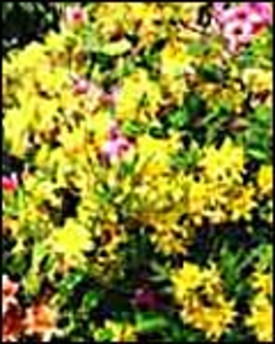One of the eternal quests of gardeners is a display of color and beauty that delights the eye all year round. Like Jason’s pursuit of the golden fleece, it’s not an easy task. But one can do it. It just takes planning and time, plus eternal additions and replacements. A year round display requires what’s called a “Sequence of Bloom”, where one chooses different plants whose colors and flowers appear at different times, in orderly succession, so something is always interesting.
Well planned gardens contain plants that catch our attention at all seasons in a continuous changing panorama. We tend to think mostly of flowers, particularly bulbs, perennials and annuals, but in fact many trees and shrubs also provide color, flowers, berries or interesting foliage.
 |
|
The sequence of bloom in cool climates is as follows. (For more southerly places, it begins a month or two earlier, depending on how far south one is.) Though northern gardens reach their zenith on that magical day in May when the whole world seems to be one large bouquet, spring really begins when the first shy bulbs like crocus, squill and chionodoxa peek out from the melting snow. The sequence of bloom continues with the flowers of early spring, such as forsythia, early rhododendrons, magnolia and cherry trees and other early flowering bulbs.
Later, in May, blossoms of azaleas and rhododendron blooms clamor for our attention along with the crabapple trees and dogwoods. Perennials begin to flower and the main spring burst of tulips and daffodils burst forth.
By early June, all the perennials are out like gang busters along with roses and kousa dogwoods. Nothing is so rare as the garden on a day in June, if you can find such a day between the end of the biting flies and the coming of the mosquitoes, that is.
From May through June, old fashioned, big, messy, deciduous flowering shrubs like bridal wreath, spirea, lilac and viburnum surprise us, all covered with blossoms, that is if they’ve been pruned at the right time. (The right time for pruning spring shrubs is immediately after they flower, not late summer, fall or early spring.)
About mid-July this explosion of flowers ends and the annuals begin to share glory with the late season perennials like phlox, daylilies and rudbeckias. Perhaps summer flowering shrubs like hydrangea and rose of sharon may fill the shrub borders.
 |
|
By the end of August, it is the annuals that must provide color because most of the perennials look tired as their mature leaves work to photosynthesize carbohydrates for next year. One can buy flowering asters, chrysanthemums and pansies to fill the bare spots for now. Sedum spectabilis is one fall perennial that will reliably bloom again next year.
As the season progresses, the annuals take center stage to complement the fall foliage pageant that unfolds. Remember, fall colors are also part of the garden sequence of bloom, as are the evergreens that take over in winter. Trees, shrubs, branches, subtle foliage colors, even snow are all part of the seasonal beauty in a garden.
In a proper succession of bloom, each plant has a charm of its own and should be counted as part of the total landscape. It’s a sophisticated concept and takes time to develop. When you add new plants, think how they will fit in with what you have and how they will please you in future years. Flowers are the most important part, but not the only part.
How to Make Your Own Sequence of Bloom
I keep a calendar list on which I note the dates and places that the garden needs something colorful. Then I look around the neighborhood to see if there’s anything in bloom I would like growing there, and I try to buy it. In the meantime I fill the drab spots with something temporary, usually annuals that catch my eye.
A garden where something happens each month is more interesting than a feast-or-famine. The architectural backbone of a well-planned garden is carefully placed trees and shrubs, complemented by bulbs and flowers all of which create the sought after sequence of bloom. Of course, it’s never finished. And one never has enough room.
Using Perennials to Create a Succession of Bloom
Trying to create a good sequence of bloom using only perennials is complicated because perennials bloom for only a few weeks each. Yet they are so lovely that we don’t want to do without them, so we add annuals and bulbs too.
There are newer perennial varieties that bloom for long periods the yellow Stella d’oro, daylily, for instance. Another is coreopsis Moonbeam, with small pale yellow flowers that keep coming all summer.
Rudbeckia goldsturm (chosen the 1999 perennial of the year) a black-eyed susan daisy type flower blooms during summer and into fall. Another way to have a long sequence of bloom is to make use of designs planned by professional landscape designers. Some combinations of plants are for sun, others for shade.
Burpee has a fall catalogue of flowers and bulbs with collections for different conditions and times of year. There are four different flower bed designs of bulbs and perennials, each for a different time of year, which together give almost six months of constant succession of bloom. There is also a collection of perennials for a sunny spot, and a shade garden of hosta and bulbs.
I still like to read a paper catalogue in bed and dream about the flowers I’m going to grow in my garden. If perennials are used wisely, combined with annuals and bulbs, and especially used to complement trees and shrubs, the whole effect can be beautiful year round, and then we can delight in the colors.
Credit: Mother’s Garden




























